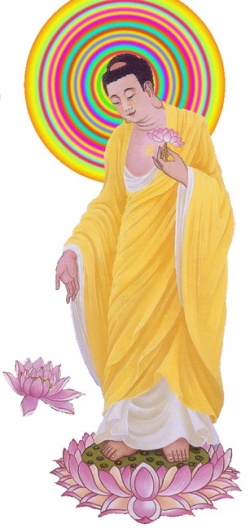Amida
Amida (Japanese): Also known as Amitabha. The Buddha of Limitless or Boundless Light. The Buddha who is the main object of devotion in the Pure land school of Chinese Buddhism, and the Jodo and Shin schools of Japan.
Amida
阿弥陀 ( Jpn; Skt Amitayus or Amitabha)
The Buddha of the Pure Land of Perfect Bliss in the west. Amida is the Japanese transliteration of the first half of both Amitayus and Amitabha, names referring to the same Buddha that appear in Sanskrit texts and are rendered in Chinese as the Buddha Infinite Life (or the Buddha of Infinite Life) and the Buddha Infinite Light (or the Buddha of Infinite Light) respectively. The Sanskrit word amita means infinite. Amitayus is a compound of this word with ayus, which means life, and Amitabha with abha, which means light. According to the Buddha Infinite Life Sutra, immeasurable kalpas ago, a certain king, delighted with the preaching of a Buddha named World Freedom King (Skt Lokeshvararaja), renounced the throne to follow him. He took the name Dharma Treasury (Dharmakara) and began to practice bodhisattva austerities under the guidance of the Buddha. After examining an infinite number of Buddha lands and pondering for five kalpas, the bodhisattva Dharma Treasury made forty-eight vows in which he pledged to create his own Buddha land upon attaining enlightenment, a land that would combine the most outstanding features of all those he had examined. In the eighteenth vow, he pledged to bring all sentient beings who placed their hopes of salvation with him (Shan-tao, a patriarch of the Chinese Pure Land school, interpreted this to mean calling upon the name of Amida Buddha) to this Buddha land, which he named Perfect Bliss (Sukhavati), except those who had committed the five cardinal sins and those who had slandered the correct teaching. Dharma Treasury completed his practice and became the Buddha Amida. His pure land was established in a part of the universe located "a hundred thousand million Buddha lands to the west" of this saha world. Belief in Amida Buddha spread from India to China. After its introduction to Japan, Honen (1133-1212) was responsible for popularizing it there and establishing the Pure Land (Jodo) school. See also Nembutsu; Pure Land school.
